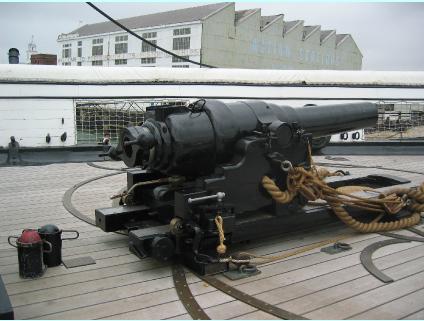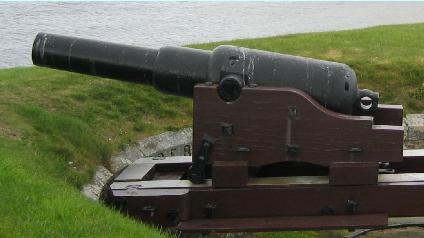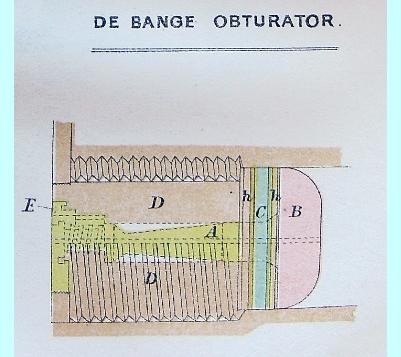| Home | Wiki | Docs | Sources | Contact |

| RIFLED BREECH LOADING GUNS |  |  |
The 12 inch guns fitted in HMS Dreadnought (1906) were the result of 20 years of development in breech loading (BL) main armament in the Royal Navy. Rifled Breech Loading (RBL) guns, after the Armstrong design, were introduced in the 1850’s, and many examples can be seen in HMS Warrior. The need for a gun capable of throwing a shot with sufficient momentum to pierce the armour plate being fitted to the warships of that time, a trend started by the French in La Gloire, (1853) requires either a very large spherical shot (such as the Rodman 16 inch smooth bore muzzle loader used on Monitors during the American civil war) or an elongated shot – such as we are familiar today. However a conical shot, will tumble unless it is rotating about its longitudinal axis and hence must be fired from a rifled barrel. Armstrong guns were fitted widely in the RN, but they suffered a number of design weaknesses. During the bombardment of Kagoshima (Japan) in 1863 there were 28 accidents in the 365 rounds fired from 21 guns. On a number of occasions the vent pieces were blown from the guns. The guns were also inaccurate. This prompted the RN to reverting back to muzzle loading (ML) guns for the larger pieces.[1] Another weakness of Armstrong guns was that there was nothing to prevent the gun being fired before the breech was closed. [3] To fire conical shot from Rifled Muzzle Loaders (RML), a number of strategies were used, such as fitting lugs onto the shell that engaged in deep rifling groves cut into the barrel. Rifled muzzle loaders were quite successful. They were cheap to build, and existing smooth bore guns could easily be converted. They were easier and faster to load, and had a higher muzzle velocity for the time. However, rapid progress was being made in metallurgy, chemistry and engineering capabilities. This lead to a race between the ship designers who installed ever thicker wrought iron armour plate (reaching 24 inches in HMS Inflexible) and the gun designers and chemists who built more powerful guns that would penetrate the thickest plate that manufacturers could forge. To penetrate thicker armour requires a large shell travelling at a high velocity. The problem was that the propellant, gunpowder, explodes in the chamber of a gun, creating a large amount of gaseous products in a very short time. As a result, a high internal pressure builds up very quickly, requiring a heavily reinforced breech end. Rodman in the USA realised that the slower the powder burnt, the lower was the peak pressure developed, and so less reinforcing was needed. Guns could be made lighter. Rodman developed Prismatic powder, where gunpowder was pressed into hexagonal tablets with a holes through the face. The highly compressed powder burns slower, and because of the holes, the prism burns from the inside out, as well as the outside in. Effectively, the holes mean that the burning surface area remains roughly constant, hence the rate at which gas is generated remains roughly constant. Prismatic powder gives a longer steadier push to the shell, whereas more granular powder would give the shell a hard kick. However (and there will be a lot of howevers in this essay) if the shell leaves the barrel before the slow burning powder has finished burning, that extra powder is wasted. To get the benefit from slow burning powder, the barrel must be made longer. In a rifled muzzle loader this introduces the problem of how to reload. The short RMLs would recoil inboard, where the crew could reload within the protection of the ship’s armoured side or turret, but this was impracticable for the longer guns. Turrets in the Devastation and Inflexible had to train to a fixed loading position and depress their guns to line up with external hydraulic loading rams. These guns were too long and fired too heavy a shot for ramming to be done manually. |
||||
 |
||||
110 pdr Armstrong RBL on HMS Warrior |
||||
 |
||||
Rifled Muzzle Loading Gun |
||||
From 1863 to 1879 the RN built ships fitted with rifled muzzle loaders. However, in 1879 one of the 12 inch guns in HMS Thunderer blew up after being double loaded (double loading could not have happened in a breech loader). This accident may have tipped the balance in favour of breech loaders, but a lot of progress had been made in Europe on the design of rifled breech loaders (RBL). |
 |
||||
The French had stayed with RBL guns when the RN switched back to muzzle loaders, and two of their inventions stand out. The interrupted screw breech allowed a breech piece to be locked and unlocked by turning it through only a fraction of a circle, typically 30 degrees. This allows the breech to be swiftly opened and closed securely. The other was the de Bang obdurator – the mechanism that seals the rear of the powder chamber when the charge ignites. Without this seal, hot gasses would burn away the screw threads, and rapidly destroy the breech, and possibly injure the gun crew. The de Bang obdurator was significantly superior to the home-grown obdurators developed by the British arms manufacturers (e.g. the Elswick cup.) |
|||
 |
|||
The de Bang obdurator consists of a stalk (A) passing through the breech block at the end of which is a mushroom head. Over the neck of the stalk between the mushroom head (B) and the end of the breech block (D) is placed a wad (C). This wad is composed of asbestos and mutton fat pressed into shape by hydraulic pressure, secured in a canvas cover, and enclosed between two disks composed of tin plates strengthened at the edges by steel rings (h). On firing, the head is forced back by the pressure of the gas against the asbestos wad, and squeezes it out against the walls of the chamber of the gun, thus preventing all escape of gas to the rear. The wad is sufficiently elastic to regain its shape on the cessation of pressure, allowing the breech to be opened. [7] |
|||
HMS Colossus was destined to be the first British warship to be fitted with the new style RBLs, and I have taken this ship as the starting point of the story of the development of breech loading naval guns up to HMS Dreadnought. |
|
 |  | ||
| (c) 2008 Rob Brassington, all rights reserved | |||